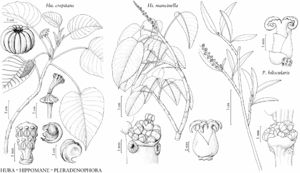Hura crepitans
Sp. Pl. 2: 1008. 1753.
Trees, to 30 m; latex copious, caustic. Leaves: stipules leaving scar around stem, 6–10 × 2–4 mm; petiole 10–20 cm, glands 2 adaxially at apex; blade broadly ovate to orbiculate, 10–25 × 8–15 cm, base cordate, margins crenate-serrulate with 10–20 teeth on each side, apex acuminate; midvein and secondary veins prominent. Staminate inflorescences: peduncle (2–)5–10(–15) cm, fertile portion 2–5 cm, 60–80-flowered; staminate bracts membranaceous, enclosing flowers prior to anthesis. Pedicels: pistillate 1–5 cm. Staminate flowers: calyx cup-shaped, 1 mm, 3–5-lobed; staminal column to 2.5 mm, anthers usually in 2, rarely in 3, whorls. Pistillate flowers red; calyx cup-shaped, 3–5(–8) mm, 5-lobed; style 30–50 mm, terminating in thick apical disc 1 cm diam. with 5–20 radiating lobes 5–10 mm. Capsules depressed-globose, 3–5 × 6–10 cm. Seeds brownish, 15–20 mm diam., 5–8 mm thick, smooth.
Phenology: Flowering Jan–May; fruiting (Mar–)May–Sep.
Habitat: Hammocks and disturbed ground.
Elevation: 0–10 m.
Distribution
Fla., West Indies, Central America, South America, widely cultivated and often escaped throughout tropical regions of the world.
Discussion
In the flora area, Hura crepitans is found only in Miami-Dade and Monroe (Keys only) counties. The capsules dehisce explosively, producing a loud sound and throwing the seeds up to 45 m (M. D. Swain and T. Beer 1977).
Selected References
None.
